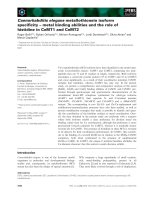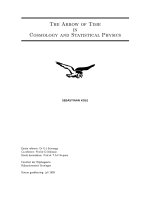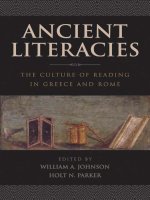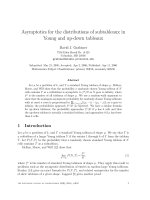- Trang chủ >>
- Khoa Học Tự Nhiên >>
- Vật lý
ancient literacies the culture of reading in greece and rome feb 2009
Bạn đang xem bản rút gọn của tài liệu. Xem và tải ngay bản đầy đủ của tài liệu tại đây (3.92 MB, 447 trang )
Ancient Literacies
This page intentionally left blank
Ancient Literacies
The Culture of Reading in Greece
and Rome
EDITED BY
William A. Johnson and Holt N. Parker
1
2009
3
Oxford University Press, Inc., publishes works that further
Oxford University’s objective of excellence
in research, scholarship, and education.
Oxford New York
Auckland Cape Town Dar es Salaam Hong Kong Karachi
Kuala Lumpur Madrid Melbourne Mexico City Nairobi
New Delhi Shanghai Taipei Toronto
With offices in
Argentina Austria Brazil Chile Czech Republic France Greece
Guatemala Hungary Italy Japan Poland Portugal Singapore
South Korea Switzerland Thailand Turkey Ukraine Vietnam
Copyright # 2009 by Oxford University Press, Inc.
Published by Oxford University Press, Inc.
198 Madison Avenue, New York, New York 10016
www.oup.com
Oxford is a registered trademark of Oxford University Press.
All rights reserved. No part of this publication may be reproduced,
stored in a retrieval system, or transmitted, in any form or by any means,
electronic, mechanical, photocopying, recording, or otherwise,
without the prior permission of Oxford University Press.
Library of Congress Cataloging-in-Publication Data
Ancient literacies : the culture of reading in Greece and Rome / edited by William A. Johnson and
Holt N. Parker.
p. cm.
Includes bibliographical references and indexes.
ISBN 978-0-19-534015-0
1. Transmission of texts—Greece. 2. Transmission of texts—Rome.
3. Books and reading—Greece. 4. Books and reading—Rome. 5. Literacy—Greece.
6. Literacy—Rome. I. Johnson, William A. (William Allen), 1956– II. Parker, Holt N.
Z1003.5.G8A53 2009
302.2’24409495—dc22 2008020329
Figures 2.1–2.6, 2.8b, and 2.9 are printed courtesy of the Trustees of the American School of Classical
Studies at Athens. Permission to reproduce Figure 2.7 granted by the German Archaeological
Institute; photograph by Eva-Maria Czako
`
, negative no. D-DAI-ATH-Kerameikos 6147, all rights
reserved. Permission to reproduce the squeeze in Figure 2.8a was kindly granted by the Centre for
Ancient Documents, Oxford University. Figures 4.1–4.5 were drawn by Nate Bullock. Figures 10.1
and 11.2 are printed courtesy of the Egypt Exploration Society. Figure 11.1 was drawn by John Wallrodt.
Figure 12.1 is printed courtesy of the Getty Museum: Gift of Mr. and Mrs. Halsted B. Vander Poel.
Research Library, The Getty Research Institute, Los Angeles, California (2002.M16). Figure 12.3
is printed by permission Luciano Pedicini, fotografo.
987654321
Printed in the United States of America
on acid-free paper
Acknowledgments
On April 28–29, 2006, the University of Cincinnati convened a Semple
Symposium under the rubric ‘‘Constructing ‘Literacy’ among the Greeks
and Romans.’’ That conference was the origin of the volume in your
hands, and first thanks must therefore go to th e Louise Taft Semple
Fund, whose financial generosity made the conference possible, and to
Louise Taft Semple herself, to whose memory we dedicate this book. We
hope to have succeeded in forwarding her wish ‘‘to make vital and
constructive in the civilization of our country the spiritual, intellectual,
and aesthetic inheritance we have received from Greece and Rome’’
(establishment document, Louise Taft Semple Fund). We also thank the
many colleagues and students and friends who formed such a lively and
invested audience during the two days of the conference. But this is no
simple volume of proceedings, and we must also express our gratitude to
the contributors, who not only gave splendid lecture presentations, but
took seriously the charge to refashion their talks into chapters for this
book and also graciously received and responded to editorial demands for
further revision. Finally, it is a pleasure to record the contributions of our
graduate assistants: Jamie Reuben, who adroitly managed the myriad
details of organizing the Semple Symposium, Austin Chapman, who
has done a masterly job in proofreading and other aspects of the produc-
tion of the book, and Dana Clark, our helpmeet in the final stages of
production.
William A. Johnson
Holt N. Parker
This page intentionally left blank
Contents
List of Illustrations, ix
Abbreviations, xi
List of Contributors , xiii
1
Introduction, 3
William A. Johnson
PART I: SITUATING LITERACIES
2 Writing, Reading, Public and Private ‘‘Literacies’’:
Functional Literacy and Democratic Literacy in Greece,
13
Rosalind Thomas
3 Literacy or Literacies in Rome?, 46
Greg Woolf
4 Reading, Hearing, and Looking at Ephesos, 69
Barbara Burrell
5 The Anecdote: Exploring the Boundaries between
Oral and Literate Performance in the Second Sophistic,
96
Simon Goldhill
6 Situating Literacy at Rome, 114
Thomas Habinek
PART II: BOOKS AND TEXTS
7 The Corrupted Boy and the Crowned Poet: or, The
Material Reality and the Symbolic Status of the Literary
Book at Rome,
143
Florence Dupont
8 The Impermanent Text in Catullus and Other
Roman Poets,
164
Joseph Farrell
9 Books and Reading Latin Poetry, 186
Holt N. Parker
PART III: INSTITUTIONS AND COMMUNITIES
10 Papyrological Evidence for Book Collections and
Libraries in the Roman Empire,
233
George W. Houston
11 Bookshops in the Literary Culture of Rome, 268
Peter White
12 Literary Literacy in Roman Pompeii: The Case of
Vergil’s Aeneid,
288
Kristina Milnor
13 Constructing Elite Reading Communities in the
High Empire,
320
William A. Johnso n
PART IV: BIBLIOGRAPHICAL ESSAY
14 Literacy Studies in Classics: The Last Twenty Years, 333
Shirley Werner
PART V: EPILOGUE
15 Why Literacy Matters, Then and Now, 385
David R. Olson
Index Locorum,
405
General Index, 415
viii Contents
Illustrations
Figure 2.1: Athenian Agora XXV, Ostraka, no.89 19
Figure 2.2: Athenian Agora XXV, Ostraka, no.1097 20
Figure 2.3: Athenian Agora XXV, Ostraka, no.768 20
Figure 2.4: Athenian Agora XXV, Ostraka, no.762 21
Figure 2.5: Athenian Agora XXV, Ostraka, no.198 21
Figure 2.6: Athenian Agora XXV, Ostraka, no.1065 22
Figure 2.7: Kerameikos ostrakon inv. 2242, DAI 29
Figure 2.8a: Fragment of IG i
3
272 31
Figure 2.8b: ATL vol. I, plate IV, First Stele, List 3 32
Figure 2.9: Fragment of IG i
3
422 35
Figure 4.1: Ephesos, plaza south of the Hellenistic agora:
schematic plan 71
Figure 4.2: Ephesos, plaza: reconstruction at start of first
century
C.E.73
Figure 4.3: Ephesos, plaza: reconstruction late in first century
C.E.76
Figure 4.4: Ephesos, plaza: reconstruction at mid-second century
C.E.79
Figure 4.5: Ephesos, plaza: reconstruction in late second century
C.E.84
Figure 6.1: Tabula Iliaca Capitolina (MDAI(R) vi (1891) pl. v) 128
Figure 10.1: P.Oxy. 2659. A list of writers of comedy and titles of their
works 242
Figure 11.1: Public Libraries in cen tral Rome 270
Figure 11.2: Relief from Ostia, inv. no. 130 281
Figure 12.1: M. Della Corte, drawing of CIL 4. 7129– 7131 295
Figure 12.2: Line drawing of hexameter outside House of Fabius
Ululitremulus (CIL 4. 9131) 300
Figure 12.3: Painting of writing materials from Pompeii (MANN
4676) 303
ix
This page intentionally left blank
Abbreviations
ATL: Meritt, B.D., H. D. Wade-Gery, and M. L. McGregor.
1939–1953. The Athenian Tribute Lists. Princeton.
CIL: Corpus Inscriptionum Latinarum. 1863–. Berlin.
FPL-Bla
¨
nsdorf: Bla
¨
nsdorf, Ju
¨
rgen. 1995. Fragmenta poetarum
Latinorum epicorum et lyricorum praeter Ennium et
Lucilium. 3rd ed. Leipzig.
IG: Inscriptiones Graecae . 1873–. Berlin.
ILLRP: Degrassi, A. 1957–1963. Inscriptiones Latinae
Liberae Rei Publicae. Florence.
IvE: Inschriften von Ephesos. 1979–1981. Inschriften
griechischer Sta
¨
dte aus Kleinasien 11–17. Bonn.
LIMC: Lexicon Iconographum Mythologiae Classicae.
1981. Zurich.
LTUR: Steinby, Eva Margarita. 1993–2000. Lexicon topographi-
cum urbis Romae. Rome.
OCD: Hornblower, Simon, and Antony Spawforth, eds.
2003. Oxford Classical Dictionary. 3rd ed. Oxford.
ORF: Malcovati, E. 1955. Oratorum Romanorum Fragmenta.
2nd ed. Turin.
PIR
2
: Prosopographia Imperii Romani. 1933. 2nd ed.
Berlin and Leipzig.
RIB: Collingwood, R. G., and R. P. Wright. 1995.
The Roman Inscriptions of Britain. 2nd ed. Gloucester-
shire.
SEG: Supplementum Epigraphicum Graecum. 1923. Leiden.
TLL: Thesaurus Linguae Latinae. 1900–1990. Leipzig.
xi
This page intentionally left blank
Contributors
Trained at New York University and at Harvard, BARBARA BURRELL has dug
at sites across the Mediterranean, including Spain, Italy, Greece, Turkey,
and currently in Israel, where she is Field Director for the Promontory
Palace Excavations at Caesarea Maritima. Her specialties include Roman
provincial coins, Greek epigraphy of Asia Minor, and Hellenistic and
Roman imperial arc hitecture, art, and history. Her major work on cities
that built temples to the imperial cult, Neokoroi: Greek Cities and Roman
Emperors, appeared in 2004. She is currently Associate Professor of
Roman Archaeology at Brock University, as well as Associate Research
Professor of Classics at the University of Cincinnati.
F
LORENCE DUPONT is Professor of Classics at the University Paris Denis-
Diderot. With interests in Roman theater (tragedy and comedy) and
the anthropology of Roman culture, her research now focuses on
ethnopoetics. In 2007 she founded the Groupe de recherches en
ethnopoe´tique (GREP). She is the author of many books and articles.
Her most recent books include L’o rateur sans visage, essai sur l’acteur
romain et son masque (2000), Fac¸ons de parler grec a`Rome(2003),
coauthored with Emmanuelle Valette-Cagnac, and Aristote ou le
vampire du the´aˆtre occidental (2007).
J
OSEPH FARRELL is Professor of Classical Studies at the University of
Pennsylvania, where he teaches courses on Latin literature and Roman
culture. He is the author of Vergil’s Georgics and the Tradi tions of Ancient
Epic (1991), of Latin Language and Latin Culture from Ancient to Modern
Times (2001), and of papers on various aspects of Latin literature.
S
IMON GOLDHILL is Professor of Greek at Cambridge University. He has
published extensivel y on Greek literature from Homer to the late an-
tique, but specializes on Greek tragedy. His current research projects
include a five-year program, Abandoning the Past in Victorian Britain,
and a three-year project, Art and Law in Modern Society. His most recent
books are How to Stage Greek Tragedy Today (2007) and Jerusalem, City
of Longing (2008).
xiii
THOMAS HABINEK, Professor of Classics at the University of Southern
California, is a specialist in Latin literature and Roman cultural history.
His many publications include The Colometry of Latin Prose (1985), The
Politics of Latin Literature (1998), and The World of Roman Song (2005),
winner of the Classics and Ancient History Award presented by the
Association of American Publishers. He is currently investigating the
potential impact of new developments in neuroscience, cognition, and
evolution on issues and problems in the humanities.
G
EORGE W. HOUSTON is Professor of Classics Emeritus at the University
of North Carolina at Chapel Hill. His research interests include Latin
literature, Latin epigraphy, Roman technology, and libraries and book
collections in the Roman world. He has published extensively on ancient
libraries, including papers on the per sonnel of public libraries (TAPA
2002), public libraries in the city of Rome (MEFRA 2006; with T. Keith
Dix), and book collections in Egypt ( GRBS 2007). He is currently at
work, with T. Keith Dix, on a book-length study of the contents and
management of book collections in the Roman world.
W
ILLIAM A. JOHNSON is Associate Professor of Classics and Head of
Department at the University of Cincinnati. He works broadly in the
cultural history of Greece and Rome, with particular interest in ancient
books, readers, and reading. Among his many articles is the winner of the
2000 Gildersleeve Prize, ‘‘Towards a Sociology of Reading in Classical
Antiquity.’’ Bookrolls and Scribes in Oxyrhynchus, a close study of ancient
papyrus bookrolls, was published in 2004, and he is presently completing
a volume, Readers and Reading Culture in the High Empire, for Oxford
University Press.
K
RISTINA MILNOR is Associate Professor of Classics at Barnard College in
New York City. She is the author of Gender, Dom esticity, and the Age of
Augustus: Inventing Private Life (2005), which won the 2006 Goodwin
Award of Merit from the American Philological Association. Her research
interests include early imperial prose and poetry, feminist theory and
gender studies, and the intersection of material and literary cultures. She
has publ ished articles on Plautus, Sulpicia, Livy, the graffiti art movement
in the 1970s, and Barbie1. She is currently working on her second book,
on literary graffiti from Roman Pompe ii.
D
AVID R. OLSON is University Professor Emeritus of the Ontario Institute
for Studies in Education at the University of Toronto. He is author of The
World on Paper: The Conceptual and Cognitive Implications of Writing and
Reading (Cambridge University Press 1994), Psychological Theory and
Educational Reform (2003), and Jerome Bruner (2007). He is editor with
Nancy Torrance of the forthcoming Cambridge Handbook of Literacy.
xiv Contributors
HOLT N. PARKER is Professor of Classics at the University of Cincinnati and
Fellow of the American Academy in Rome. He has published on Sappho,
Sulpicia, sexuality, slavery, sadism, and spectacle.
R
OSALIND THOMAS works on literacy and orality in ancient Greece. She has
written Oral Tradition and Written Record in Classical Athens (1989), and
Literacy and Orality in Ancient Greece (1992). Her research interests also
include Greek law and the polis, Greek medicine, and historiography.
Her most recent book is Herodotus in Context. Ethn ography, Science
and the Art of Persuasion (2000). She is Tutorial Fellow and University
Lecturer in Ancient History at Balliol College, Oxford.
S
HIRLEY WERNER taught at Rutgers University and the University of
California, Irvine, and served as the American Fellow to the Thesaurus
linguae Latinae in Munich. She has published on Latin poetry and
manuscripts. She works as the Associate Director of the American Office
of L’Anne´e philologique and has recently joined the editorial board of
the journal Vergilius as Bibliographical Editor.
P
ETER WHITE is Professor of Classics at the University of Chicago. He has
written extensively on the relationship between Latin literature and the
structure of Rom an society during the Late Republic and Early Empire.
His books include Promised Verse: Poets in the Society of Augustan Rome
(1993), for which he received the American Philological Association’s
Goodwin Award for Merit in 1995. He is currently completing a book
about Cicero’s letters.
G
REG WOOLF is Professor of Ancient History at the University of
St Andrews. He has written on European prehistory, the cultural history
of the Roman provinces, the Roman economy, and Roman religio n. Along
with Alan Bowma n he edited Literacy and Power in the Ancient World
(1994) and contributed a chapter on the subject to the Cambridge Ancient
History. He is currently working on patterns of cultural change in Roman
antiquity, and on science in the Roman world.
Contributors xv
This page intentionally left blank
Ancient Literacies
This page intentionally left blank
1
Introduction
William A. Johnson
A previous generation of scholars made ancient Greece a point of central
focus in arguments concerning literacy. In these earlier accounts (one
thinks in particular of Jack Goody, Eric Havelock, and Walter Ong),
literacy was isolated as a primary agent of change in the ‘‘Greek revolu-
tion’’—what Brian Street has dubbed the ‘‘autonomous model’’—in
which the introduction of an alphabetic writing system, in and of itself,
is said to bring about various consequences for society and culture.
1
Such
determinist accounts are now generally discredited, both at large and
among most classicists.
2
Yet little has arisen to take its place. Classicists
have only slowly begun to take advantage of the important advances in the
way that literacy is viewed in other disciplines (including in particular
cognitive psychology, sociolinguistics, and socio-anthropology).
3
The
most widely referenced general book remains William Harris’ Ancient
Literacy (1989), a thoughtful, immensely learned, and important book,
which, however, focuses narrowly on the question of what percentage of
people in antiquity might have been able to read and write.
4
The moment seems right, therefore, to try to formulate more interest-
ing, productive ways of talking about the conception and construction
of ‘‘literacies’’ in the ancient world—literacy not in the sense of whether
10 percent or 30 percent of people in the ancient world could read or
write, but in the sense of text-oriented events embedde d in particular
sociocultural contexts.
5
The volume in your hands was constructed as a
1. Goody 1963, 1977; Havelock 1963, 1986; Ong 1982; Street 1984.
2. See summary and critique in Street 1984, 44 65; Thomas 1992, 15 28; Olson 1994,
1 20, 36 44; Johnson 2003, 10 13.
3. For overviews of the tendencies, see in this volume Thomas (chapter 2: for Classics)
and Olson (chapter 15: for a broader view), and the bibliographical essay by Werner
(chapter 14).
4. Harris 1989; reactions collected in Humphrey 1991.
5. UNESCO has defined literacy in terms of the illiterate: someone ‘‘who cannot with
understanding both read and write a short simple statement on his everyday life’’ (quoted in
Harris 1989, 3). But sociological researchers have proposed definitions with a much broader
cast to the net: for example, Shirley Heath (1982, 50) speaks of ‘‘literacy events’’ as ‘‘occasions
3
forum in which selected leading scholars were challenged to rethink from
the ground up how students of classical antiquity might best approach the
question of literacy, and how that investigation might materially intersect
with changes in the way that literacy is now viewed in other disciplines.
The result is intentionally pluralistic: theoretical reflections, practical
demonstrations, and combinations of the two share equal space in the
effort to chart a new course. Reade rs will come away, therefore, with food
for thought of many types: new ways of thinking about specific elements
of literacy in antiquity, such as the nature of personal librarie s, or the
place and function of bookshops in antiquity; new constructivist ques-
tions, such as what constitutes reading communities and how they fashion
themselves; new takes on the public sphere, such as how literacy inter-
sects with commercialism, or with the use of public spaces, or with the
construction of civic ident ity; new essentialist questions, such as what
‘‘book’’ and ‘‘reading’’ signify in antiquity, why literate cultures develop,
or why literate cultures matter.
SITUATING LITERACIES
Rosalind Thomas’s opening essay (‘‘Writing, Reading, Public and Private
‘Literacies’: Functional Literacy and Democratic Literacy in Greece’’) serves
as an introduction and overview of the inquiry. Her essay takes as its starting
point the observation that we need to speak of a multitude of ‘‘literacies’’
that play out in different ways in different contexts. She focuses on the ways
that different uses of reading and writing are embedded in specific institu-
tions in classical Athens, such as the distinct uses of literacy in banking
and other commercial activities, the use of names and lists in citizenship
activities, and the particular needs and uses of reading and writing among
Athenian officials. Her aim is to tease out specific literacy practices that
can be associated with separate social, economic, and political groups.
Along somewhat similar lines, Greg Woolf in his essay (‘‘Literacy or
Literacies in Rome?’’) focuses on inscribed objects under the Roman
empire, and what they tell us about the uses of literacy in specific social
and commercial contexts; but also what such uses say more generally
in which written language is integral to the nature of participants’ interactions and their
interpretive processes and strategies’’; Brian Street (1988, 61) of ‘‘literacy practices,’’ referring
thereby to ‘‘both behaviour and conceptualisations related to the use of reading and/or
writing’’; and R. D. Grillo (1989, 15) of ‘‘communicative practices,’’ in which he includes ‘‘the
social activities through which language or communication is produced,’’ ‘‘the way in which
these activities are embedded in institutions, settings or domains which in turn are implicated
in other, wider, social, economic, political and cultural processes,’’ and ‘‘the ideologies, which
may be linguistic or other, which guide processes of communicative production.’’ These are
summarized and discussed further in Street 1993, 12 13; Johnson 2000.
4 Ancient Literacies
about the ‘‘joined-up’’ relationship between private uses of writing and
literacy practices as they are developed by the state.
Barbara Burrell (‘‘Reading, Hearing, and Looking at Ephesos’’) exam-
ines more literally the situating of inscribed writing in its cont ext, as she
explores the complex relationship between inscriptions and public space
in the grea t plaza in Ephesus known, in particular, for the Library of
Celsus. Texts, architecture, and de
´
cor of public buildings are considered
in tight, reflective relationship to one another; and she charts as well an
evolving readers’ response over time as new dedi cations and new struc-
tures are added to the plaza such that it ultimately becomes a hallmark of
the intersection of Hellenic and Roman culture.
Simon Goldhill’s essay (‘‘The Anecdote: Exploring the Boundaries
between Oral and Literate Performance in the Second Sophistic’’), by
contrast, focuses on literary culture. He explores the sudden popularity of
‘‘anecdote’’ in the Second Sophistic and how that speaks to the wa ys that
literate practices can be situated in oral performance in distinct social
settings. The anecdote as a written form is seen as emblematic of the
literary culture of the time, a characteristic packaging of material that is
best understood in relation to actual oral practices among the literary
elite. As an originally oral form that can be written down, and once
written down memorized and recirculated orally, the anecdote becomes
a normative means whereby a book ish, highly educated elite compete in
the symposium and other contexts.
Thomas Habinek (‘‘Si tuating Literacy at Rome’’), looking at the
Roman evidence, also empha sizes the interdep endence of oral and literate
as he tries to situate writing in what he sees as the predominate oral
culture at Rome. In a broad-ranging essay, he looks at writing (1) dia-
chronically, sketching an account of the early use of writing for assertion
of status and Roman identity; (2) synchronically, describing what is at
stake socially in the mastery of literate practices; and (3) ontologically,
examining the ‘‘embodied’’ character of wri ting, whereby writing is seen
not as a representation of speech but as something material, and thus with
its own opportuni ties but also its own strictures and constraints.
BOOKS AND TEXTS
The three essays that follow focus on working out the relation between
book and text, a longstanding and productive area of inquiry in Classics.
Florence Dupont (‘‘The Corrupted Boy and the Crowned Poet or The
Material Real ity and the Symbolic Status of the Literary Book at
Rome’’) explores in nuanced fashion the nature of the symbolic status
and function of the bookroll. Her interest lies in the tension between the
fragile physical book and the ways in which the text—the ‘‘fictive utter-
ance’’ for which the book acts as vehicle—can escape that fragility. For
Dupont, th e literary book by Alexandrian times is in concept no more
Introduction 5
than a container, a copy of something composed in the past; and this
conceit is one that Catullus and the Augustan poets use to advantage, as
they strive to establish themselves among the ones who are qui primus,
the ‘‘first’’ to create the foundational, ‘‘consecrated’’ text that is preserved
so as to be imitated and commented on, thus sealin g their status as
canonical authors, worthy of the Greeks.
Joe Farrell (‘‘The Impermanent Text in Catullus and Other Roman
Poets’’) is likewise interested in the emphasis in the Roman poets on
the fragi lity of the physical bookroll. For Farrell, too, this emphasis entails
a paradox, but of a different sort. He wishes, rather, to focus on the
curious way in which the poets, even while recognizing material texts
as the vehicle for gaining a wide and lasting audience, repe atedly express
anxieties over the corruptibility and ‘‘impermanence’’ of the physical
text. The image of the bookroll is linked, in Catullus and others, with
the ceremonial presentation copy, and thereby, he argues, attracts asso-
ciation with anxieties over public reception of the work and the alienation
of the work from the poet’s control; for these reasons, the image of
the bookroll is inherently ambivalent, and the increasing emphasis on
‘‘song’’ and ‘‘singer’’ in the Augustan poets a fitting, if also strictly ana-
chronistic, turn.
Holt N. Parker’s essay (‘‘Books and Reading Latin Poetry’’) also focuses
on the image of the book and its reception, but from a diffe rent strategic
angle. This essay is written as a challenge to the sometimes careless
comfort with which Romanists speak of ‘‘orality’’ and ‘‘performance’’
when speaking of classical Latin poetry. Althou gh acknowledging the
importance of recitations, entertainments at dinner parties, and use of
professional lectors, Parker advocates a return to the communis opinio of
an earlier era, namely, that such communal activities were preparatory or
complementary to ‘‘the unmarked case of private reading.’’ In a wide-
ranging analysis, he questions the notion that Augustan Rome was an
‘‘oral society’’ in any meaningful sense, and underscores the poets’ own
statements about their expectations for a readership divorced from per-
formance, and extending in time and space.
INSTITUTIONS AND COMMUNITIES
Several essays examine the social institutions or communities in which
literate practices may be said to be ‘‘embedded.’’ George Houston
(‘‘Papyrological Evidence for Book Colle ctions and Libraries in the
Roman Empire’’) surveys the papyrological evidence for perso nal libraries
and book collections under the empire. Along the way he has much of
interest to say about the activity of book collecting and the people who
did this collecting. General conclusions emerge, however tentatively,
about the nature of book collecting and use over time: there seems a
distinct tendency toward collections garnered together mostly in a limited
6 Ancient Literacies
time period, with specific goals (such as accumulation of philosophical
texts), followed then by use, with only occasional augmentation or main-
tenance, over a succession of generati ons.
In similar fash ion, Peter White (‘‘Bookshops in the Literary Culture of
Rome’’) surveys what we know of ancient bookshops and booksellers in
Rome. Again, investigation of details leads to discovery. As an institution,
bookshops had a commercial identity that differentiated them from other
small shops, because they were concentrated in a small sector of the city,
had distinctive conventions of sale, and fostered special types of literate
sociability. The modes of engagement with texts are themselves of inter-
est, because they privilege the use of a book as a commodity—there is
value, for example, in being able to size up a book for its antiquity or
authorship, without attention to substantive content. But the central role
of niche players, such as grammatici, in bookshop society is yet more
striking, a demonstration of how ‘‘hyper-literacy converted into social
performance’’ facilitated social movement and allowed non-elite to gain
entry to the highest literary circles in Rome, moving thereby into posi-
tions of considerable social authority.
Kristina Milnor (‘‘Literary Literacy in Roman Pompeii: The Case of
Vergil’s Aeneid’’) looks at the placement and function of literary texts
written as graffiti on the walls of Pompeii. Taking Vergil as a sample set,
she explores ‘‘literary literacy’’ for the variety of ways it speaks to the
interests and attitudes of the ancient writers and readers. Her theoretical
stance is explicitly localizing, avoiding universal explanations in favor of a
focus on the unique character of each text in its context, as she tries to
tease out, in particular, the writers’ view of the relationship between
Vergil’s text and their own act of inscribing. The specific interpretations
lend themselves nonetheless to a general conclusion: the use of canonical
literary texts seems to open the door to a special kind of discourse, by
which the Vergilian tags function less as a cultural product and more as
a means of cultural production (‘‘less facts than acts and . . . aware of
themselves as such’’).
William Johnson (‘‘Constructing Elite Reading Communities in
the High Empire’’) similarly insists on a focus on particulars and
specific contexts as a means to work towards more general conclusions.
Taking Gellius’s Attic Nights as an illustrative example, he presents a
methodology for exposing the sociology of certain types of reading events
in the Nights, including both reading in groups and reading alone, as he
explores the ‘‘nuts and bolts’’ of how a specific reading community makes
use of texts. This then leads to conclusions about the ideological com-
ponents of reading events. At basis, his theoretical angle is constructivist,
that is, he sees the ancient literary text as a vehicle by wh ich the ancient
writer (in this case Gellius) and the ancient community (‘‘Gellius’s
world,’’ in his terms) not only construct ‘‘best practice’’ ways for using
texts but also construct defined significances for different types of reading
events.
Introduction 7
BIBLIOGRAPHICAL ESSAY AND EPILOGUE
Shirley Werner’s bibliographical essay and index (‘‘Literacy Studies in Clas-
sics: The Last Twenty Years’’) give a convenient, quick overview of the last
generation of literacy studies in Classics, followed by a topical index and the
bibliography itself. Defining the boundaries of ‘‘literacy studies’’ can be at
times a task more pragmatic than theoretical; the omission of books and
articles on orality in the Homeric epics, for example, will surprise no one
who pauses to think through the consequences. Chronological limits are
arbitrary, but rooted in the conviction that William Harris’s work (1989)
marked a turning point in literacy studies in Classics. Harris’s bibliography is
extensive, even though it does not claim to be comprehensive, and we thus
agreed to take the last year of Harris’s active collecting, 1987, as an approxi-
mate boundary in Werner’s bibliographical assemblage.
By way of coda to the collection, David Olson offers an essay (‘‘Why
Literacy Matters, Then and Now’’) with both a review of the last co uple
of generations of work in literacy as it impinges on Classics, and his own
take on the relationship between the objectification of written text and
linguistic features of quotation. Building on ideas developed in his earlier
work, Olson sees writing as neither equivalent to speaking nor utterly
divorced from speaking. Specifically, he sees written text to share with
quoted expressions (whether written or spoken) the characteristic that
the understanding of illocutionary force—how the utterance is intended
to be taken—is something that needs to be added in order for the expres-
sion to be understood. The distance between expression and understand-
ing leads, in the case of written texts, to a range of reading compete ncies,
and Olson isolates the fully competent reader as one who is not only
‘‘critical’’ (grasping the author’s attitude) but ‘‘reflective ’’ (understanding
both the author’s attitude and the reader’s own percepti on of that atti-
tude). This trained ability to separate the attitude of an utterance from the
propositional content has important cognitive consequences, since one
can then use language to reflect on language in ‘‘pure thought’’ fashion;
and this then helps account for why writing is so important in the
development of modern thought and the growth of literate traditions.
As we try to step back from this sampling for the la rger view, the first
thing to notice is what is not there. No one in this group is speaking of,
or in terms of, gross estimations of the literate population. Harris
(1989) seems to have marked a turning point in that, however one
evaluates his conclusions, he seems to have put paid to that line of
inquiry. Similarly, there is an interesting, perhaps surprising, lack of
emphasis on the long-central set of scholarly debates on the importance
of ‘‘orality’’ and ‘‘performance’’ for ancient literacy;
6
and in any case the
6. Perhaps because study of orality and performance has become a subdiscipline
itself, rather than a point of distinction in literacy studies.
8 Ancient Literacies









